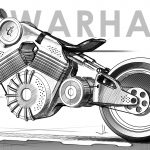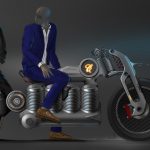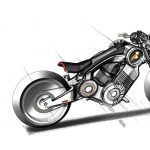Exclusive inside story of the relaunch of Curtiss Motorcycles as a premium electric motorcycle manufacturer
All good things must come to an end, and after practicing the Art of Rebellion for a quarter of a century by manufacturing a total of 1,300 outrageously unconventional, totally uncompromising V-twin American maxi-cruisers since it was founded in Louisiana in 1992 by former trial lawyer Matt Chambers, Confederate Motors Inc. has built its last-ever such bike, thus marking an end to 23 years of iconoclastic innovation.

That’s because on January 8th, 2018 this maker of literally unique V-twin motorcycles changed its name, while also formally signalling its intention to abandon the use of internal combustion engines in its products. That’s the day the company which today is based in Birmingham, Alabama, after being expelled from its New Orleans home by Hurricane Katrina in 2005, and is still headed by Matt Chambers as President/CEO, was renamed the Curtiss Motorcycle Co., named after the legendary American motorcycling and aviation pioneer Glenn H. Curtiss. His most notable achievement on two wheels was to set a World Land Speed Record of 136.36 mph (219.45 km/h) in January 1907 at Ormond Beach, Florida on a 40bhp 269ci/4,410cc V8-powered motorcycle which he’d designed and built himself, before thereafter totally transferring his attention to airplanes, and to emulating the feats of the Wright Brothers. His record would stand for another 23 years before it was beaten.

But whereas Confederate’s various models have hitherto all featured muscular engines that were as loud in action as they looked likely to be at rest, the born-again Curtiss brand’s debut model, the Hercules that’s scheduled to be unveiled on May 5th at the Quail Motorcycle Gathering in Carmel, California, will waft along to the sound of silence while delivering much-needed designer looks to the electric bike marketplace. It’ll be powered by two electric motors made by California’s Zero Motorcycles, linked together in a patented modular system to deliver massive torque and vivid acceleration. Curtiss Motorcycle Company will focus exclusively on producing a range of electric-powered two-wheelers which Matt Chambers says will “fit every pocketbook.” He intends this should translate into a sub-$30K sticker price, which contrasts still further with Confederate’s status as the mucho expensivo boutique brand of two-wheeled choice for America’s rich and famous. Serial celebrities ranging from Hollywood A-listers Tom Cruise, Brad Pitt and Nicholas Cage, through to rock idols Bruce Springsteen and Steven Tyler, and country music star Tim McGraw, are to be found in Confederate’s roster of high-profile owners, often with more than one of these exquisitely crafted and consequently costly two-wheeled works of art in their garages.. It’s a two-wheeled status symbol.
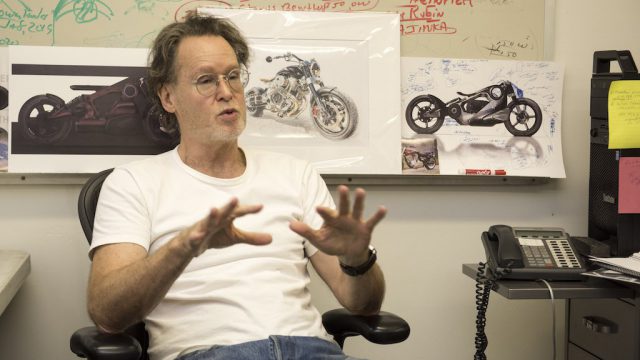
The chance to talk to Matt Chambers at Curtiss Motorcycles’ Birmingham. Alabama factory about this radical switch in direction provided more details on what’s set to be America’s first prestige two-wheeled EV brand.
AC: Matt, what are your plans for Curtiss Motorcycles’ comeback to the marketplace after more than a century away?
MC: Curtiss Motorcycle Company will focus exclusively on producing a range of electric-powered two-wheelers which will fit every pocketbook, so I’m figuring a sub-$30K sticker price, with the unveiling of our first model, the all-new Hercules, scheduled for May 5th, 2018. Seven years ago, in our twentieth year, we began research and development of our fifth generation architecture. We knew we were at a turning point; we had maxed out Glenn Curtiss's invention of the V-twin American motorcycle. It was time to apply our years of design experience and earned wisdom with the best innovation and technology, just as Mr. Curtiss would do if he were leading us today. The Curtiss models will deploy a modular architectural system, the design of which we’ve filed numerous patents on, as the foundation for an all-new Twin-Engine powertrain from the world leader in motorcycle torque production, Zero. Their all-new powertrain package embodies a classical proportion, that’s lower, narrower, and with superior weight management to any other two-wheeled EV. The geometry and ergonomics are classic, too, empowering the rider with effortless control, as well as massive acceleration, top speed, handling, and comfort. Curtiss suspension will also be all-new and state-of-the-art, plus we’ll have a breakthrough in transparency, accuracy, and quality of information between the tarmac and the Curtiss rider. Whole new levels of safety have been designed into the Curtiss, which has the goal of being the world leader in this key aspect of riding on the highway. We’re turning many pages here.

AC: How long have you owned the rights to the Curtiss Motorcycles name, and why are you using it on your first electric motorcycles?
MC: We’ve owned the Curtiss trademark for about seven years, and we acquired it because of my admiration for the achievements of Mr. Curtiss, who I believe was a truly visionary person, and a great motorcyclist. Glenn H. Curtiss was three years ahead of Indian in creating the American V-twin – which they then copied, just as Harley-Davidson did five years later. He was running 136 mph on a motorcycle when those guys were running 50 or 60 mph, and bragging about it. And then he got bored with the whole two-wheel thing, and went off and essentially created flight with the Wright brothers. But he was the one flying the planes, and he designed the engines powering his aircraft, and it’s his rudder design, and all his technology that flies planes today, not theirs. He was a very brave man, because he not only rode his own motorcycles on Ormond Beach, but he also flew his own aircraft, including the seaplanes he invented. He was a man’s man – he was a guy who took inordinate risks, he was obviously an incredible technologist, but he’s unknown to the world today! I have great respect for the Harley story, the Indian story and the Triumph story and the BMW story, these are great stories – Honda’s story is a great story. But Glenn Curtiss dwarfs them all, and that’s not a put down to them, just that he was a true innovator whom they essentially copied. I think if Mr. Honda were still with us he’d say, “Oh, I’m no Glenn Curtiss!” I really think he would say that.
AC: OK, so you’ve answered ‘why Curtiss?’ – but why electric, and why electric and Curtiss together?
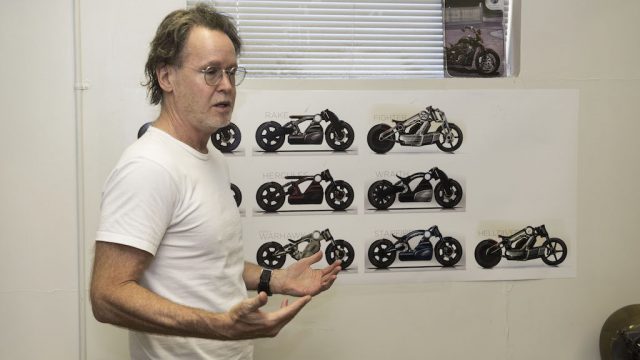
MC: Because if Glenn Curtiss would show up today, I think his thirst for innovation and his genius for free-thinking would lead him to developing a unique take on electric motorcycles, and that’s what we intend to do with the products bearing his name.
AC: So he’d be showing Tesla’s Elon Musk how to do it on two wheels rather than four?!
MC: I think he would be right in there with him. I believe Mr. Curtiss would very much approve of what we’re doing, because he invented the American V-twin by looking at two single-cylinder motorcycle engines and putting them on a common crank. So the idea of having two Zero electric motors paired together is very Glenn – the Curtiss Hercules electric motorcycle with twin Zero motors would be just like his first V-twin.
AC: What are your plans for working with Zero on the Curtiss E-bikes?
MC: Zero will definitely be the tier one technology supplier for our powertrain. We have that agreement in writing, and I feel that’s going to be a great long term relationship, having discussed with them what their interests are, and what our interests are. I know they’re a great benefit for us, but I believe in return we can really give them something that will bring an extra dimension to the EV marketplace. They’re going to supply us with their latest technology in a twin motor package, which is estimated to have 290 foot pounds of torque [393Nm – AC], and in the neighbourhood of about 175 horsepower. This is an air-cooled package, and it’ll have dual controllers, and the battery packs they’ll make for us will be dedicated to the Curtiss models.
AC: It’s important to underline that Zero may obtain the cells elsewhere, but they make their own batteries and controllers, which will presumably help you in styling the motorcycle, as well as delivering range?

MC: Yes, that’s a key ingredient for us. The Curtiss Motorcycle Company Inc. is being set up to essentially operate like an aircraft manufacturer. So if we were Boeing, then we would buy Rolls-Royce or Pratt & Whitney engines to use in our fuselages, and this is in keeping with where we were from the very beginning with Confederate. I’ve always looked at motors as being if we can grab a motor off the shelf, that will be just as good as or better than the one we could make. I want to have a technology partner, i.e. Zero, that will do this for us, and we’ll just piggyback with them on that aspect of it. What we will be 100% focused on is, again, to use the flight analogy, the controls and the design of the plane itself, and how that flies. They’ll power the plane, but we’re going to fly it, so the first Curtiss Hercules will have exactly what our Confederate Fighter has, the same feeling as the Fighter. It’ll have about the same weight, but much lower in the chassis by a significant amount. So the 100 pounds [45kg – AC] that sits up at the top of the V via the cylinder heads, will now be more or less down at axle level on the Curtiss, which will make the motorcycle feel lower, and will give it better steering at lower speeds.
AC: Are you still going to have the cylindrical battery packs that you envisaged in your designer Jordan Cornille’s initial drawings you showed me?
MC: There’s going to be variations on the theme of how the batteries are packaged, but they’ll all be very low in the chassis with one exception, which will be the V-configuration that’ll have a little higher weight. What we’re going to do is to offer numerous ‘blocks’, as we call them. There’ll be six basic blocks: T-block, Y-block, Porcupine-block, V-block, I-block, Slant-blocks, so six altogether. These blocks are the batteries of the motorcycle, and their carriers are monocoque with the steering head and the engine. So basically, they’ll be six essentially aesthetic configurations of how the batteries can live within the motorcycle. But the key here is that the geometry, at least initially, will be very close to what we already know the great American road bikes should ideally have to go down the road well, including our Confederates. The feeling of this, all the energy from our prior work, will be imbued in that machine. There will be several great advantages however, in how narrow the motorcycle is, and how we can position the footrests exactly where they should be – wait and see! One of the things I’m so excited about is that the scale of the Curtiss motorcycle is very much like bikes were in the 1930’s. What’s happened with today’s giant combustion engines, is that they sit three or four inches above the top of the tower, and this creates its own aesthetic. Like on a Harley, where the Blockhead motor’s rocker box is nowhere as nearly as lovely as the Shovelhead or any of the Panheads, or Knuckleheads. So it works OK – but working and aesthetics are two different things. And the giveaway is that the Shovelhead was an inch lower, and believe it or not, that one inch makes an enormous difference in the way that the whole aesthetic and proportion of the motorcycle looked, and looks.

AC: So to summarise, for future Curtiss models you project a twin-motor product which will have a variation of different aesthetic solutions for the battery pack. With telescopic front suspension or a Confederate Fighter girder-type front end?
MC: We’re working with Paul Thede at Race Tech Suspension on a new inverted telescopic fork design for the Curtiss. Look, we’ve done good work on the Fighter front end and I like it, but the disadvantages are increased unsprung mass, and then you also have all these little bearings that give you several other points of movement that need to be addressed. So, I know that our first Curtiss Hercules model will have a telescopic front end – but a new form of telescopic fork, something very fresh.
AC: And will this have a sport cruiser type feel to the riding position – relatively rangy and raked out?
MC: Alan, we’re going to have everything that the client could want. Curtiss will deliver cool and sophisticated urban mobility, by deploying a modular architectural system, a design on which numerous patents have been filed, as the optimal foundation for an all-new Twin-Engine powertrain supplied by the new world-leader in motorcycle torque production, Zero. The all-new powertrain packages will come in a classical proportion -lower, narrower, and with superior weight management than any other such powerpack. The geometry and ergonomics are classic as well, empowering the rider with effortless control, speed, handling, and comfort. Curtiss suspension is all-new and state-of-the-art. We’re promising a breakthrough in transparency, accuracy, and quality of information between the tarmac and the Curtiss rider. Whole new levels of safety have been designed into Curtiss, which has the goal of being the world leader in this key aspect. We have a full range of machines in development to fit every pocketbook.
AC: So can you make a bespoke motorcycle to suit any particular client’s choice?

MC: In the first year we’re going to build just a handful of bikes, no more than two or three hundred motorcycles, as a kind of test strategy for manufacture. So when we launch the Curtiss motorcycle, we’re going to be very focused on the California market, it’s going to be a motorcycle for which we have a very targeted audience of younger folk in Silicon Valley, and then the kind of guys that ride up and down Mulholland Highway, that go to the Rock Store, and all that. So we’re going to look to put all of the initial production into that marketplace first, and then in the following year, or 18 months after that, we’re looking at something that would be akin to a mass customisation. What I’m hoping I can do is to get someone to say, ‘This is my dream, I can purchase a Curtiss and essentially get proven technology that works’. So you will receive some of the core characteristics the bike must retain, but then you’ll be able to choose from a menu of other different features, including the ergonomics which can be any way you want it. We’ll have some differences available in terms of the rake and trail, depending on whether you see yourself as more of a canyon carver, or a straight line cruiser – we’re likely not going to go over 27º of rake, so you’ll get a choice between, say, 24º and 27º – things like this.
AC: But while customising certain details of the bike for purchasers, what Curtiss will be doing is what nobody else has done yet, and instead of kind of apologising for the batteries having to be there to power the bike, you’re going to actually make them an aesthetic focus of the whole motorcycle. True?
MC: Yes – but what I’m envisaging is that I’m going to get these young guys on a motorcycle, and we’re going to let them change these integral design features of it, using the different blocks of batteries. But battery technology is developing very fast, and whereas today you have a bike with an 80 or 100 mile range running at 70 mph, or, 130 or 140 miles if you’re in stop-and-go traffic, we know that in ten years’ time it will be a much different situation, and you’ll be able to get 500 miles from the same battery real estate. It’s only going to get better. If it’s something like the transistor scenario, it may be doubling capability in terms of range and recharging time every four or five years. So the cool thing is that we can furnish the customer with this motorcycle, this Curtiss Hercules, and he can keep it forever, and he would be able to constantly update it. The motors have very few moving parts, so they’re not likely to wear out, the controller can be constantly reprogrammed or replaced, meaning the only thing that you really need to update is the battery and the drive chain – not belt, because of the huge torque we’ll have on offer. It’s a bike for life that you can constantly keep changing.
AC: So when will you be able to deliver the first Curtiss machines?
MC: The one thing that we know is that on May 5th we’re going to hold the global launch of Curtiss Motorcycle Company Inc. by unveiling its first product, plus we’ll have all our partners on stage with us at the Quail event in Carmel. We’ll already have numerous pre-production motorcycles, and we’ll have a better idea from that point on how fast we can actually start to deliver motorcycles to customers.

AC: At what sort of price level?
MC: Well, as I said earlier, we hope that we can filter products into a range from $25,000 to $30,000. Maybe our first products will carry a little bit of a premium, as part of a Founders edition. But the goal is to grow the company, to create a scalable manufacturing model by resourcing the liquidity that’s available based essentially on a pre-selling model. One thing that I really admire about what Mr Musk did, is that he got out there with that Tesla Model 3. and presold half a million automobiles. So our goal will be to go out and essentially get a book of orders. We’re not going to start building motorcycles and then put them in dealerships, and build up an inventory, we’re going to essentially build them to order at this start-up stage.
AC: Where will you manufacture them?
MC: We’re going to build the first 300 here in Birmingham. But we’re going to create a new environment for the second and third year onwards – going forward based upon what our projections are, and I think we’ll have a pretty good idea from when we strike the match on May 5th. Probably by the end of May we’ll have a good sense of what the interest in this program is going to be, and whether or not there really are people out there in their thousands who want to purchase a Curtiss E-cruiser – is it thousands, or is it hundreds, or is it tens of thousands? Anyway up, it’s going to be way more than anything Confederate was ever able to do. By the way, I do think we will have enormous support – our outreach is across all aspects of business, into government, etc. We’ve been looking for partnerships, looking for co-branding opportunities, and I would be surprised if there aren’t numerous companies that want to team with us, and hop on the Curtiss bandwagon.
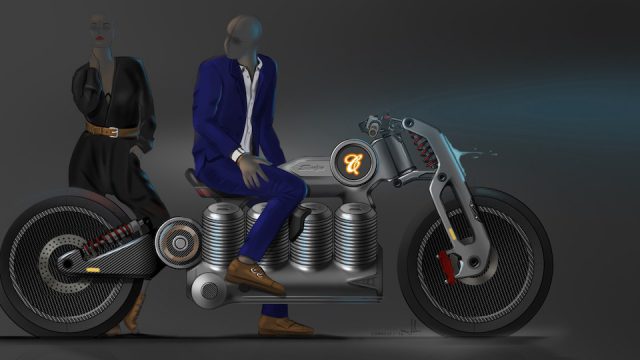
AC: Are you hoping that future Curtiss models will be viewed as taking a step forward beyond whatever anybody else has done with two wheeled electric vehicles so far?
MC: Well, it’s absolutely a question we need to consider. I’ve ridden numerous Zero motorcycles, and I love them. The only thing I don’t like about riding a Zero is the way I feel on the bike. Look, I know it sounds a little wonky, but I guess I’m kind of a nerdy guy in that I like fashion, I love clothing, I like how things look, and a motorcycle experience to me includes the way my client looks on his motorcycle, how he feels on it, how he feels integrated into the bike going down the road, the way it looks when people see him riding it. All that is a major factor in terms of his ability to kind of stop the passage of time a little bit, to have his awareness grow, all in the most positive way. So my problem with the Zero motorcycle, and indeed all the electric motorcycles I’ve ridden so far, has been more aesthetic than anything else. I believe that Curtiss’s contribution to this will be to make E-bikes sexy, and cool! Very, very sexy, and very, very cool. When someone goes riding on these first electric Curtiss models, I hope they’ll be like, ‘You know, I never felt like this on a motorcycle before – and especially not on a combustion motorcycle.’ We’re looking at changing people’s responses, to help them be environmentally aware – but without feeling nerdy. We want the Curtiss Hercules to be a gamechanger – in appearance as well as performance.
Read more:
Ducati Panigale V4 catches Fire in traffic
2018 Piaggio MP3 Yourban Review. Insane Scooter with Car License

